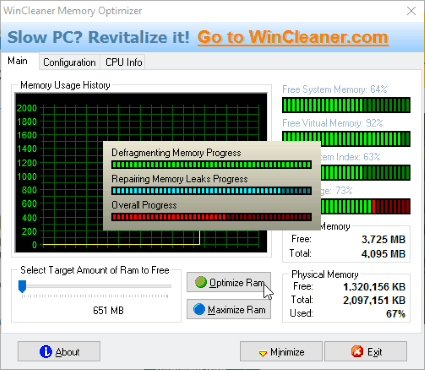


#Freememory pro code
Therefore, the penalty for the convenience of not annotating object lifetime manually in the source code is overhead, which can impair program performance. GC uses computing resources to decide which memory to free.
#Freememory pro free
Certain kinds of memory leaks, in which a program fails to free memory occupied by objects that have become unreachable, which can lead to memory exhaustion.Double free bugs, which occur when the program tries to free a region of memory that has already been freed, and perhaps already been allocated again.By then the memory may have been reassigned to another use, with unpredictable results. Dangling pointers, which occur when a piece of memory is freed while there are still pointers to it, and one of those pointers is dereferenced.GC frees the programmer from manually de-allocating memory. ( April 2021) ( Learn how and when to remove this template message) Unsourced material may be challenged and removed. Please help improve this section by adding citations to reliable sources. Post-hoc GC is sometimes called litter collection, to distinguish it from ordinary GC.

Some of these post-hoc GC systems do not require recompilation. Still others, like D, are garbage-collected but allow the user to manually delete objects or even disable garbage collection entirely when speed is required.Īlthough many languages integrate GC into their compiler and runtime system, post-hoc GC systems also exist, such as Automatic Reference Counting (ARC).
#Freememory pro manual
Some languages, like Ada, Modula-3, and C++/CLI, allow both garbage collection and manual memory management to co-exist in the same application by using separate heaps for collected and manually managed objects. Other languages, such as C and C++, were designed for use with manual memory management, but have garbage-collected implementations available. These are said to be garbage-collected languages. Many programming languages require garbage collection, either as part of the language specification (e.g., RPL, Java, C#, D, Go, and most scripting languages) or effectively for practical implementation (e.g., formal languages like lambda calculus). ( July 2014) ( Learn how and when to remove this template message) Please help improve this article by adding citations to reliable sources. This section needs additional citations for verification.

Some such methods de-allocate memory as well. Resources other than memory, such as network sockets, database handles, windows, file descriptors, and device descriptors, are not typically handled by garbage collection, but rather by other methods (e.g. Garbage collection may take a significant proportion of a program's total processing time, and affect performance as a result. Other, similar, techniques include stack allocation, region inference, and memory ownership, and combinations thereof. Garbage collection relieves the programmer from doing manual memory management, where the programmer specifies what objects to de-allocate and return to the memory system and when to do so. Garbage collection was invented by American computer scientist John McCarthy around 1959 to simplify manual memory management in Lisp. The garbage collector attempts to reclaim memory which was allocated by the program, but is no longer referenced such memory is called garbage. In computer science, garbage collection ( GC) is a form of automatic memory management. After that, the working memory contents is discarded in favor of the compressed copy, and the role of working and free memory are exchanged (depicted).


 0 kommentar(er)
0 kommentar(er)
